#space tourist (derogatory)
Text
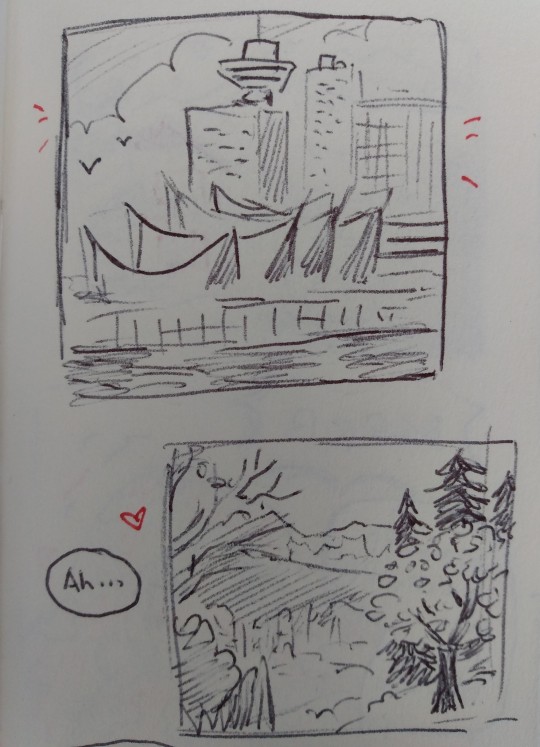
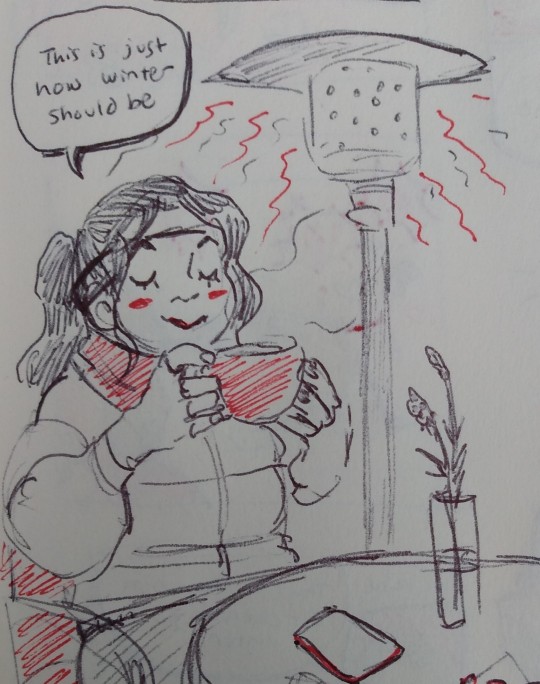

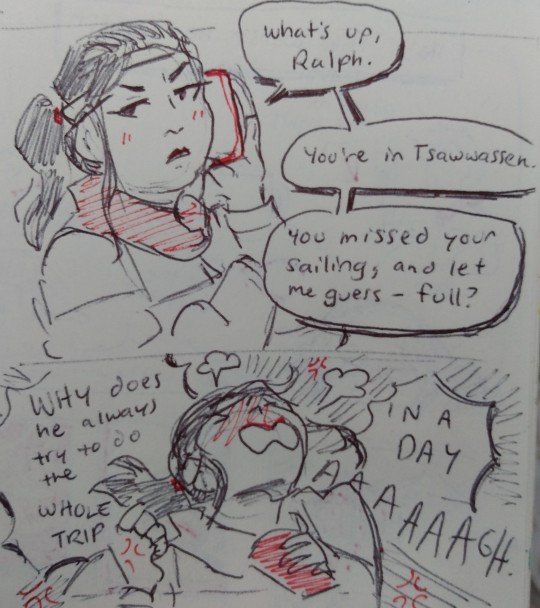
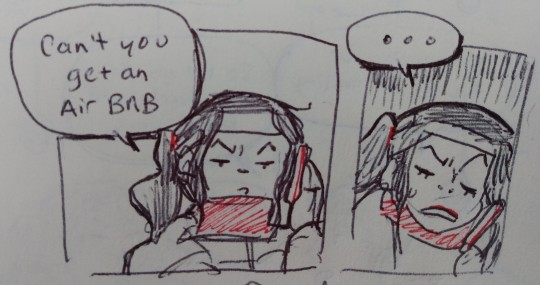
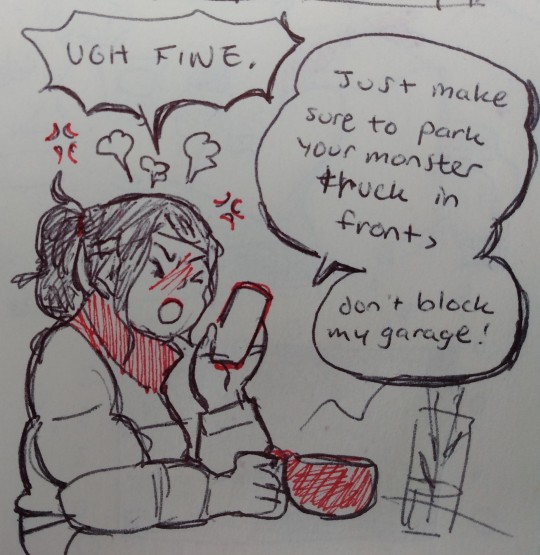

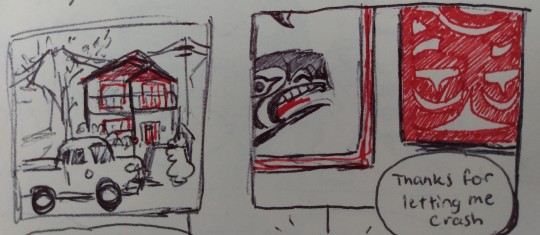
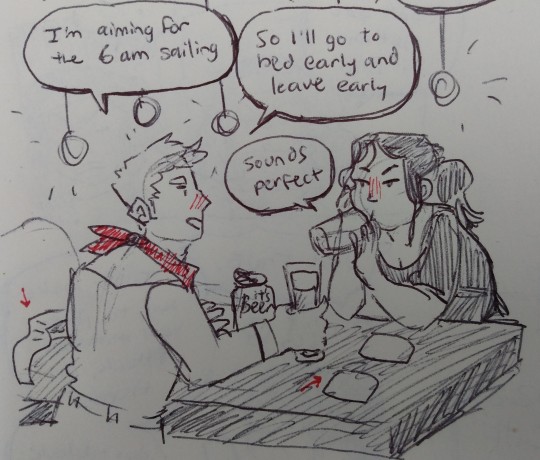


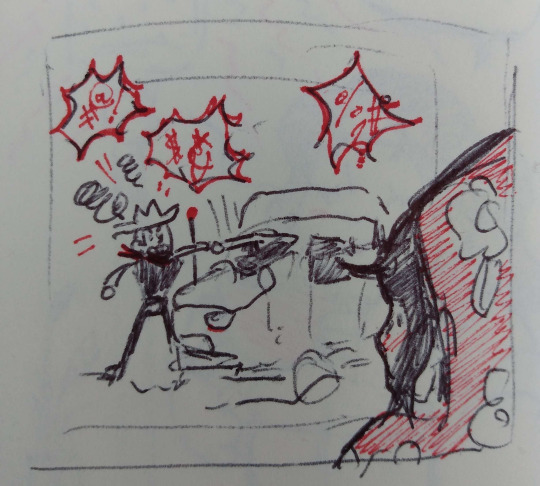

SO i need to do more comics about bc and since i can’t finish my condensed milk comic
- decided that bc CAN sit out on a heated patio because she has +25% cold tolerance from the north half of the province
- red plate is a derogatory term for anyone driving an alberta truck because we tend to be bad/aggressive drivers (tbh so are people from bc lol) and because compared to plates of other nearby provinces you can usually spot our candy cane red plates a mile away (but only on the back, we don’t have front plates and usually have either nothing or a dumb vanity plate there so that’s how to clock us from that angle lol)
- for the purposes of this comic i decided she lives in a Vancouver Special. I kind of picture BC’s house as SUPER SLEEK on the inside and renovated frequently and kind of cold and uninviting but she also has TONS of art on the walls, its a very curated space. Likewise I think while she has lots of space for entertaining and puts a lot of stake in her ability to host visitors, she’s also kind of obsessive about her privacy and how she likes to keep her space. It comes with being Beautiful and having the most unique ecosystem Ever okay.
- me: im not painting an accurate portrait of the sort of house guest bert is in the condensed milk comic. actually he’s Worse. (again our reputation as tourists and drivers is about the same..)
- yeah so they cancelled the ferries to the island a day or two ago haaaaaahahahahaha....... i guess he could always fly : )
- ANYWAY YEAH GO LOOK UP HOW VANCOUVER IS DEALING WITH THIS AMOUNT OF SNOW RIGHT NOW. It’s even worse than on the island it feels like and I’ve been snowed in here for 3 days :’ ) We’re about to get hit with more snow and then non-stop (freezing) rain so that’s gonna be sooo fun...
BONUS
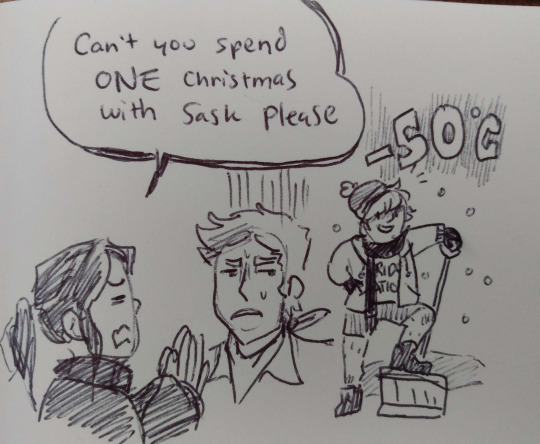

#projectcanada#iammatthewian#iamp#iamp: alberta#iamp: british columbia#iamp: saskatchewan#pc: alberta#pc: british columbia#ralph campbell#victoria van cheung#hapo doodles#traditional art#ink#comic#rocky relationship
28 notes
·
View notes
Text
Submitted via Google Form:
How can I have a tourist town in my story but somehow make it quite neat wihout too much disturbance to locals or environment. I'm thinking of stuff like the reason why no one's allowed to sit on the Spanish Steps any more or I read something about some local market that started getting too many tourists and interfered with sellers and local buyers so bad they had to move business to get away from the crowd or just plain troublemakers, should be self-explanatory. If there are massive amounts of law limiting what people do, would that help or harm more?
Feral: “Tourist town” refers specifically to locales where the economy is dependent on tourism. These are generally smaller towns that either sprung up around a destination intentionally for tourists to travel to or that existed earlier but embraced tourists, possibly as a way to keep the town from becoming a ghost town, as happened in many small towns around Area 51, for example. A tourist town would either cease to exist or have to completely change their economy if tourism stopped being a thing. In a tourist town, the majority of residents are going to be connected to the tourism industry. Consider a college town or a factory town if it helps.
Rome is not a tourist town. Rome is a city with industries of all kinds. Is tourism a part of the economy? Of course. But they can do things like prevent people from sitting on the Spanish Steps without being afraid of the city dying. As for the local market in your example, if the merchants don’t want tourists around, it’s probably because they weren’t spending money and were just taking up space and preventing actual customers from making purchases, which means this is not a tourist economy.
Tex: Law is largely cultural, and as such is primarily meant to maintain a particular definition of (local) culture. Tourists are not locals, and as such laws may be passed in high-traffic areas to preserve cultural traditions. Sometimes this means designating hours for the local market, sometimes this means that certain cultural icons (such as sculptures, particular gardens, or graveyards) will have restricted access.
If an area is not able to support itself without non-locals being there, then it is not a home or residence or town, it is an amusement park. Granted, an amusement park themed to the surrounding culture, but something artificially created for the enjoyment of outsiders who have no wish to partake in anything outside of the most superficial and easily-satisfied parts of a culture unlike theirs.
Rather unfortunately, this type of travelling is most frequently the product of a colonial attitude, and has ties into how places may be defined as “exotic” or “quaint”, among other terms that at first glance might be complimentary but in function are derogatory.
15 notes
·
View notes
Text
Taj Mahal, 1977
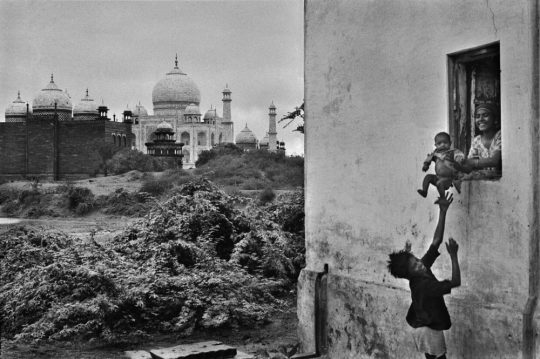
“My search for black photographers was an attempt to respond to the proliferation of negative, derogatory images of black people. White perceptions of black inferiority were often reinforced by the same images of black men that I had seen, and my intention was to challenge those images and the history books by identifying the breadth and depth of experiences of black people recorded in the photographs.” (Willis 13).
In this quote from the Introduction of Picturing Us, Willis foregrounds how essential a photographer’s identity and relationship to their subject are in any image. As she mentions in the chapter, a photographer is not neutral, and what they choose to make images of reflects their identity, background, culture, and the conditions that they inhabit. Raghu Rai's photograph is a great illustration of this idea. This picture is part of a collection my uncle shared with me a few weeks ago, and it has been stamped in my head since. Pictures of the Taj Mahal are usually framed from the front and occasionally there are aerial views, and photographers construct these images to entice tourists to visit the landmark. What I found so interesting about this image is that the Taj Mahal occupies about the same or less space than the children in the foreground. Therefore, Rai bestows the children with as much importance as he does the Taj Mahal. Unlike most other pictures of the Taj Mahal I have seen, Rai does not depict Agra, the city to which the Taj Mahal belongs, as a place to be visited and left behind. Just like New York City, Agra is a place where people live, work, and play, and travel brochure pictures intentionally obscure the life and activity of locals.
In addition, much of Western visual media about the Indian subcontinent almost exclusively depicts people suffering or being solemn. If we consider movies as thousands of images packaged together, Willis' quote also applies to poverty porn movies like Slumdog Millionaire, a film made by a British man for Western audiences. These films display serious issues stemming from colonialism and imperialism and surveys them through white saviorism, despite white saviors being a reason for widespread hunger and poverty in the Global South. This white saviorism turns people of the Indian subcontinent into objects that Westerners can project their feelings and emotions onto rather than people with agency and the capacity to solve their own problems. Instead of opting for a scene of suffering that implies a Western duty to rescue, Rai chooses a whimsical scene that is dramatic yet typical, one that many British or Western observers would not consider worthy of capturing or sharing.
Photo Credits: Taj Mahal, 1977
References: Willis, Deborah. “Introduction: Picturing Us.” In Picturing Us: African American Identity in Photography. New York: The New Press, 1994.
-- Bhargav Tata
3 notes
·
View notes
Text
I spent the weekend & past few days visiting friends in the Finger Lakes area, going to Niagara for the eclipse, and then ending in Corning for the glass museum and nearby Watkins Glen
Super fun overall but I noticed that there was a noticeable amount of retired people taking the same exact routes as me lmao
Do I have geriatric tastes? Were there just more of them because a lot of these events happened during the normal workday?? Most likely both
Moments I want to remember:
Watched a roller derby match in person, coolest and toughest gals around. Both teams and the fans went out for drinks after too and just all-around good vibes
Got the last seats at a fancy French restaurant for dinner - and the meal was on the company dime too hehe
Had a frangipane dessert for the first time and it had apricots and was amazing
Slept on a couch with a cat as my little spoon
My car may be slightly larger than my old one but the gas tank is NOT - do not wait until next rest stop bitch just go
Buffalo is actually a sizable city unlike the other upstate NY "cities"
Went to Buffalo's Dinosaur BBQ after they closed the Newark location which I miss. Ribs were so tender and tasty but overall the meal was miles short of the Texas barbeque I had last year
The NY part of Niagara Falls was far more enjoyable than the Canada side imo - it was a lot of walking paths and nature-focused attractions and the views were adjacent to the falls which I preferred. Canada side felt like an NJ boardwalk (derogatory) tourist trap and the falls views are across the river and farther away - more activities so good for families with kids or longer stays but less ideal for a 1-day visit like I did
Had my first Tim Hortons experience and it was like a cleaner Dunkin Donuts (DD my beloved I still love you more)
Went on one of the boats that goes straight into the area at the bottom of the Niagara waterfalls - a couple on board renewed their vows Jim & Pam style underneath the falls
Got DRENCHED on that boat ride, which I could have easily avoided but I was at the absolute tip of the bow, and it was cold and early April and a 30 min walk to my accommodation
Experienced ~eclipse totality~ for the first time! It was cloudy so no money-shot photo of the sun being overtaken, but got to experience the dark and the craziness with it. The birds all got confused, the streetlights all turned on, and it suddenly got so cold I could see my breath. Something about thousands of people gathered in one place and cheering and being giddy with joy together was so fun lol, felt like a concert or something but instead just staring at the sun
Stayed at the cutest accommodations, where it was a historical "castle" (mansion extended with additions to become an early doctors office and eventual B&B) and had the kindest host. The house was BEAUTIFUL and was filled with antiques and trinkets. The host was so passionate about the history of the building and making sure guests were comfy and knew about events going on nearby. She singly-handedly cooked a breakfast buffet daily and cut up a plate of fruit for each room AND cleaned all the rooms after check outs what a queen
Went to a local Niagara coffee shop that turned out to be a not-for-profit that provides a cool community space and meals for those who need it - most importantly got a delicious cappuccino
Visited the Corning Museum of Glass and easily could have spent twice as long there if it wasn't just a stop on my way home. They have an impressive collection and a bunch of live demonstrations, definitely worth a visit if you can
#eclipse#using tumblr as my diary again#i literally was just talking with my friends about how we all need to journal more#but like i dont have a physical journal#this will do for now i guess#no proofreading we die like men
0 notes
Text
A million people thrive in China’s secret underground city

Beneath the bustling streets of Beijing lies a secret underground city. Spanning an area of 78 square kilometers, this hidden metropolis is home to the “rat tribe,” a million people who cannot afford above-ground housing.
The capital city of Beijing, China, grapples with overcrowding, limited living spaces, and skyrocketing housing prices. As a result, nearly a million people have sought refuge in an underground city, unbeknownst to many. These individuals choose to reside in the cramped tunnels, remnants of a Cold War-era project (1969-1979) that enlisted over 300,000 workers. Their hope is to save enough money to eventually get an apartment with natural light.
CNN reported that despite the derogatory moniker “rat tribe” and the deplorable living conditions some endure, the underground city offers an array of amenities, including sports facilities, restaurants, hairdressers, cinemas, theaters, and other attractions that make it an intriguing destination for tourists.
Dubbed Dìxià Chéng, this underground city lies beneath Beijing’s vibrant streets, roughly 10 to 18 meters deep. Housing a million low-income residents who cannot afford above-ground accommodations, the three-story tunnels were originally constructed as bomb shelters during the Cold War and connected all the central government buildings in the city.
It is estimated that there are around 90 entrances to this city, many of which remain undiscovered by those unfamiliar with their locations. Most of the current residents, totaling around a million, are migrant workers and aspiring young people seeking opportunities in China’s capital city. While living spaces are small, crowded, and devoid of natural light, the rents are merely one-third of those found above ground.
Some residents have called this complex home for decades, while others temporarily relocate, staying until they have accumulated enough funds to secure a regular apartment in the bustling metropolis.
From a legal standpoint, nuclear shelters and residential areas are technically illegal due to a 2010 ruling by Beijing authorities. These officials cited safety hazards that negligent homeowners failed to address. However, despite the evacuation of some residents, the majority have been allowed to remain, facing an uncertain future.
What is the history of China’s secret underground city?
The construction of these tunnels commenced in 1969 during a period of heightened tensions and fear of a large-scale conflict between China and the Soviet Union. Chairman Mao Zedong of the Chinese Communist Party instructed citizens to dig tunnels, store food, and prepare for war.
Armed with shovels and bamboo baskets, people tirelessly dug by hand, sacrificing centuries-old walls, towers, and gates, including the historic city gates, to provide construction materials.
Over the course of a decade, approximately 300,000 civilians undertook this extraordinary endeavor, resulting in the creation of an impressive city with 10,000 atomic bunkers, warehouses, factories, and essential amenities such as restaurants, theaters, and sports facilities — everything a city would need to withstand a nuclear war.
What is life like in China’s secret underground city?
Life in Dìxià Chéng is not easy for its inhabitants. Many face challenges such as poor ventilation, dampness, mold, pests, noise pollution, lack of privacy, and social stigma. Some rooms are so small that they can barely fit a bed and a desk. Others have no windows or natural light at all.
However, not all residents are unhappy with their living conditions. Some appreciate the convenience and affordability of living close to their workplaces and public transportation. Others enjoy the sense of community and camaraderie among their neighbors. Some even decorate their rooms with colorful curtains, posters, plants
and personal belongings to make them more cozy and comfortable.
Some residents also take advantage of the various facilities and services available in the underground city. There are gyms, karaoke bars, internet cafes, beauty salons, libraries, and even schools and hospitals. Some of these establishments are run by the residents themselves, who have found ways to earn a living and provide for their families.
What is the future of China’s secret underground city?
The future of Dìxià Chéng is uncertain. While some residents hope to move out someday, others have grown accustomed to their subterranean lifestyle and have no plans to leave. Some even fear that they will lose their homes if the authorities decide to demolish or renovate the tunnels.
The government has been ambivalent about the existence of the underground city. On one hand, it recognizes the need to provide affordable housing for its citizens and to preserve the historical and cultural value of the tunnels. On the other hand, it worries about the safety and sanitation issues, as well as the potential social unrest and instability that could arise from such a large and marginalized population.
Some experts have suggested that the government should regulate and improve the living conditions of the underground city, rather than evict or ignore its residents. They argue that the underground city could be transformed into a unique and attractive tourist destination, as well as a valuable resource for urban planning and development.
Others have proposed that the government should invest in building more public housing and creating more job opportunities for the low-income groups, so that they can afford to live above ground and enjoy a better quality of life.
Whatever the fate of Dìxià Chéng may be, it remains a fascinating and remarkable example of human resilience, adaptation, and creativity in the face of adversity.
#UndergroundCity#DìxiàChéng#RatTribe#Beijing#HousingCrisis#ColdWarEra#BombShelters#LowIncomeHousing#LivingConditions#Amenities#TouristAttraction#History#Construction#LifeChallenges#Affordability#Community#news#madscientistwriting
0 notes
Text
space hot take of the day but touching the kármán line for four minutes in a fully automated ship does not an astronaut make and to call jeff bezos that is disrespectful against the profession as a whole he is a spaceflight participant at best
1K notes
·
View notes
Text
Ambiguous
There has been something I need to write about and shout into the void. It has been tearing me apart, and I don’t know how people will react elsewhere, so I figured this was the safest place. This will be the soft reveal before even speaking about it to my friends. Or maybe I will never speak about it ever again. Maybe I will feel fine after writing it this way.
For my entire life, people have mistaken me for being Indian, to the point where actual Indians walk up to me and start speaking in their dialect. My mile-long blank stare makes them realize that I am not Indian, and one of two things happen - they either apologize and explain they mistook me for Indian, or they exclaim, “You’re NOT Indian?”
I’m Cuban and Colombian. I grew up in New Jersey. I am an American citizen but it gets confusing when you take into account that my mother flew to Santiago, Chile to have me there because of a clinic that specialized in geriatric pregnancy at the time, so my “birthplace” reads Chile on my passport. That’s always a mouthful to have to explain and it further confuses people, so I end up saying, “I was born in New Jersey”. My skin tone is best described as ambiguous. I could be many things. I’ve gotten Middle Eastern, Indian, and specifically “Egyptian”. I have no idea why “Egyptian” but. Whatever.
I have always lived in some liminal space where people ask the dreaded question, “What are you?”
Now here’s the most frustrating thing of all - not everyone who has asked me that was white. Growing up, I thought that I could relate to someone who wasn’t white to understand how I feel. Black people have asked me that. Indian people have asked me that. Middle Eastern people have asked me that.
Cubans and Colombians have asked me that.
Throughout my youth, I was paranoid that maybe I was adopted or something, given how people didn’t seem to connect me with my parents. I was told that my Cuban side hails from Spain, but my Colombian side is shrouded in mystery. My dad never liked to talk about my family. I never knew anyone past my grandparents. Well, I did meet my great-grandmother once when I was seven, but she had practically turned back into a baby at that point, banging on the table demanding food and needing to be spoon-fed.
My own people don’t recognize me, and they often say things like, “You don’t LOOK Latino!” or “What? You’re LATINO?” and the best one yet “You don’t SOUND Spanish!” The worst offenders, however, would laugh and say, “¡Pareces Hindu!” which means “You look Hindu!” Hindu is the religion, dumbass.
Anyone, and I mean anyone, can be racist and slip some “micro-aggression”.
I am not fluent in Spanish, but I can write and understand every word in Spanish. I often inadvertently offend Spanish-speaking people when I reply to them in English when they thought they were being sneaky by talking in Spanish around me.
The reason I don’t speak Spanish as fast as my peers is because of two reasons:
1. My parents at the time when I grew up believed in the misconception and pseudoscientific belief that children will be “confused” if two or more languages are spoken in the house.
2. Central New Jersey, where I grew up, hadn’t yet seen many Hispanic people, so locals at the time often leered at people who spoke Spanish in public.
When my mother took me to our local Gymboree, I spotted a butterfly and shouted in Spanish, “¡Mariposa! ¡Mariposa!”. The other mothers kept staring at me, and then distanced themselves from us.
The weirdest thing ever was experiencing white people who studied the Spanish language better than me and making fun of me for actually being Spanish but being unable to speak it fluently. I had a crush on this girl whom I’ll call “Anjy” in freshman year of college. It took me until now to realize that I think she had a Latino fetish. Anjy only exclusively went out with Latino men, but never seemed to openly admit it. The only thing she did admit was that, “I can only be with a man who speaks Spanish. It’s so important to me.” So obviously I wasn’t a contender, despite being Latino. Anjy doesn’t have an ounce of Spanish in her. None. But she studied it since high school and fell in love with it and became Spanish’s #1 fan. I was so jealous of how fluent she was. She could roll her r’s and speak it beautifully. Since we became friends, I said to her, “Oh, I can finally practice my Spanish with someone!” We tried, but she laughed at me and said, “I’m sorry. I can’t do this anymore. You sound like a gringo.”
It’s a very topsy-turvy world where some white girl uses a derogatory term on me, a derogatory term from my culture that describes an outsider, used to describe me.
She went to Costa Rica after we graduated, lived there for a few years, and came back home with a husband.
(That’s when I fully realized just how much she fetishized us.)
A few years ago, my now-fiancée gifted me a DNA test for my birthday. That came out of left field for me, and opened up a range of emotions that I wasn’t ready for. She said she remembered how I wondered aloud why I looked the way I looked and about my ancestry.
I sat on the DNA test for a while.
I stared at it.
I held the kit in my hands.
I opened it and closed it.
What if I really was Indian? What if I found out something that made me feel so much worse? But how bad could it be?
I was also wary about the company keeping my DNA for nefarious reasons. However, luckily enough, my fiancée had bought the kit from AncestryDNA - the one DNA company that has responded to people saying they would delete their DNA at their request.
I bit the bullet and sent my sample.
When the test came back, I opened it up and everything made sense. It made so much sense that I laughed out loud. It’s so funny how nobody has guessed the only other possibility for my skin tone that is what I actually am.
I am pretty much half native to the Americas.
I’m not sure what that’s called. Native American seems to be associated exclusively to North America. So Native South American? Native to the Americas? Native American (et al)?
The Colombian side can be traced through turmoil in South America, up through Mesoamerica, and into North America. So many spots lit up all over the Americas. And like the Cuban side said, I was indeed from Spain as well. I was split right down the middle. 50/50. The native side and the European side were practically screaming at each other in my genes.
I felt as though a great weight had been lifted from me that I didn’t even know was there. I knew for a fact that I was my parents’ son. I had an explanation for why I look the way I look, and it made sense and it was obvious.
It didn’t end there though.
I didn’t feel Native American. I had no cultural connection to anything “native”. I tried thinking in terms of my personality though. I always had a strong belief in saving the land and respecting the dead. I did vandalize a construction site back in my high school days to preserve farmland. My family did like to decorate the house with Aztec and Mayan statues. Aside from that though, I had about as much personal connection to native culture as Olive Garden does to Italy.
The thing about my parents being from Cuba and Colombia is that those were two very violent and turbulent places in the past century. After I tell people where my families hail from, they always asked me with wide-eyes, “Oh have you been there???”
Well, I dunno man. If you have any inkling of what’s going on the world you would know the awkward relationship that the United States has had with Cuba, and what it means to be a fucking exile. And the fact that Colombia has seen gang wars for the entirety of my life. So no. I haven’t.
When I was a little boy I asked my parents if we would ever visit Colombia or Cuba, but they told me we shouldn’t go back. Colombia was violent, and Cuba’s government watched everyone. My mother was afraid of what would happen if she tried going back. Maybe they wouldn’t let her, or us. Maybe they’d let us through but I wouldn’t even be allowed to return if they knew I was the son of an exile. Worse yet, they might detain my mother. You never know when your family had beef with the government and was told to leave.
And what really drives a knife in my heart is hearing people ask that really annoying question. “Have you visited???” As if they were hot and exotic touristy locales. No. Because my parents were forced to flee, because they needed a better life.
“Wouldn’t your mom love it if you got married in Cuba? She would get to visit her home!”
You don’t get the trauma she has. You don’t understand how much of a toll it would take on her to return home and see all the things she once knew and love gone or tarnished. She received word recently that the farmhouse she grew up in now became a restaurant. The house that my grandfather built by hand. Strangers now sit and eat there. Maybe tourists. The hotel that my great-grandfather used to own now doesn’t belong to us anymore - the government said it was theirs. There is nothing for her to go back to but loss.
I felt distraught when I saw a former college classmate who has become an Instagram influencer immediately visit Cuba once travel restrictions were eased. She posted all about it and acted as if she were an expert about it. She used to be a lawyer in Washington D.C. until she decided to “take hold of her life” and “follow her dream” and go to Bali and now lives everyday in tropical paradise. It seemed like some people were pointing out the hypocrisy in her posts about life given the lifestyle she leads, since she felt the need to say something about it. She made a video where she tried to relate to her followers. She said how “it’s still hard” for her, that she “has to work every day”, and meanwhile literally the next fucking day she posts a picture of her having lunch by a waterfall, or napping in her hammock by the beach.
But when she visited Cuba, and took pictures and wrote a long post about the country, I just lost it. She met up with some other white Instagram influencer friend, and they took selfies at a café and lectured about the region and---
That’s supposed to be my country, my culture. I’m supposed to feel that way about my people, not you.
I went to a wedding recently in July. This black man slapped me on the back after I cracked a joke and said, “Hey, where you from?”
“New Jersey.”
He laughed. “No, but really though. Where are you from?”
“New Jersey.”
“I mean originally. Your background. What are you?”
It was the first time I had been asked that question since I got back my DNA test results, and for some reason it hit me so much differently.
I really wanted to say, “I don’t know.”
It’s ironic how knowing what I am made me feel more confused, more alone and more isolated than ever before. I am bad at speaking Spanish, and when I try to practice with other Spanish-speaking people they laugh at me and say, “You sound like a gringo” and say they can’t bear to practice with me. I don’t look Latino. I might look Indian or I might look Middle Eastern. With me, everyone assumes things about me, no matter what they are. Some people have the luxury of automatic and unspoken assumptions about their background. Then there’s me. Not quite tan, not quite white. I don’t raise enough suspicion at the airport to warrant a search but at the same time I have to jump over one extra hurdle when they ask me one extra question: “Where are you from?” or “How long are you staying here?” or “What are you here for?” It’s very subtle and deceptively innocent. Nobody else who is pasty white gets asked any questions. They just stamp their passport and wave them away. I’m just ambiguous enough to warrant that extra step - just in case, you know?
I envy people so much who can have a clear culture and place to point and say, “I’ve been there. I’ve been where I come from.” I envy people who can recognize all the idiosyncrasies of their family’s region. I don’t belong to any country or culture or identity. There are only a few scant pieces of culture that my parents passed on to me. “Oh, on Christmas we do this” or “We say this once and a while. That was a common expression there.” I envy people with huge families who have not been estranged by government and bloodshed or lost to time. I envy people who can trace their families back to their grandfathers and great-grandfathers and great-great-grandmothers. As a kid I wish I was able to say something like, “My great-granddaddy fought Nazis in the war!” I will never know anyone beyond that one old great-grandmother who no longer recognized anyone’s face. Everyone else is a name on a tombstone, or a whisper in vague oral history.
I envy people who can firmly say, “I am *insert nationality here*”
Because I always mumble at that phrase.
I am. . .a. . .
I am from. . . . uh
I am. . .
I am.
#onlife#culture#racism#ethnic minorities#ethnicity#cuba#cuban#colombia#colombian#spanish#hispanic#latino#spain#race#personal#identity#brown skin#tan skin#black#white#ambiguous#india#indian#english#language#native american#native#aztec#mayan#maya
14 notes
·
View notes
Text
The Voice in the Silence, Part I
The pandemic has really been getting to me. I think I’m hearing things—or, really, just one thing. I don’t know what is real anymore.
My favorite time of night is when I can hear the palm trees in the wind, so loud it sounds like rain even if the night is perfectly clear.
First full moon of the year. I’m standing outside, sand in my toes, bathed in the brightest moonlight casting shadows as if it were already dawn. I close my eyes as the waves quietly lap over my feet and let the sound of the palms quiet my mind.
It’s been a tough year for me. Job losses, grandparents succumbed to COVID, parents struggling to keep their restaurant afloat. And it’s just me now. College and business school— that was the plan. I was going to be the one to save all of us. I was going to buy my parents a big house on the beach with a condo close by for Abuela and Abuelo.
Guess I’m too late.
Corporate life was never for me, unfortunately. I tried to suck it up and do the whole networking thing in college but I just couldn’t bear to end up another miserable finance employee...not to mention, the side glares, the derogatory comments, the quiet laughs I got just for being female in these spaces, not to mention an immigrant.
I’d found some decent jobs here and there, but my last one was in the hospitality business and I got let go a few months into the pandemic. So here I am, living at home again, trying not to let my parents’ disappointment kill me.
The beach is my quiet place. My parents still don’t understand the need to isolate, despite their ages and despite my mother losing both parents to COVID. “Estaban viejitos, mija. Cuando Dios los necesita, no hay nada que hacer.”
I tried. I tried to get them to wear masks. To stop letting neighbors over. To get tested. To get the vaccine when it started to become available near us. Nothing was enough to convince them. So I’d escape to a quiet spot of the beach, away from the touristy shores and just let the waves roll over my feet until the wet sand pulled me ankle-deep.
That’s where I am now. But not because of frustrations with my parents about health precautions. Because...something happened, I guess? At this point, it’s hard to tell what is real and what is quarantine brain.
It was just this morning, when I think it all started. I woke up in the early, early hours of the morning, the moon still up and the sun not yet creeping above the horizon. I started on what had become my daily routine—not out of necessity, but because preparing breakfast before we opened the restaurant was the only thing I felt I could do to help my parents.
So it went: cafe brewing in the Greca, arepas warming in the oven, queso guayanes cut into thick slices on a plate, and fresh jugo de parchita on the counter.
“Emilia...”
“Aquí!” I called back, thinking one of my parents was calling for me from their room. “Su madre!” I hissed immediately after under my breath, wincing as I sliced my finger instead of the ham I was preparing.
No response. I waited for a moment, glancing down the hallway towards my parents’ room but all was silent. Shaking my head, I ran to the sink to wash the blood off of my finger. The cut wasn’t deep, thankfully, and I pressed a corner of paper towel to it until the bleeding stopped. I was just about to throw the blood-soaked scrap away and get back to the ham when I heard it again.
“Emiiiiiiliaaaaaa.....”
The voice was quieter now but also felt so much closer. Like a whisper just against my ears making the hairs on the back of my neck stand on end. I looked around slowly but my vision felt like it was blurring, just around the edges, like it was slowly going out. I shivered violently and crossed myself, shutting my eyes tightly and telling myself I was imagining things—pandemic exhaustion, too many early mornings opening the restaurant, too many late nights job hunting and poring over our finances. It was all just getting to me, that was it.
A few minutes later, my mom walked into the kitchen with my dad close behind and I started to open my eyes, slowly at first and then all at once as the bright kitchen lights came flooding in. My vision was back to normal and the voice was, apparently, gone, affirming in my mind that I had imagined all of it—a product of an overworked brain and nothing more.
“¿Que haces, Emi?” My mom was shaking her head in judgment at me while she picked up where I left off slicing the ham.
“Sorry, mami,” I muttered, holding up my finger with the bloody paper as way of explanation. “Got distracted.”
“Esta hija tuya es más despistada...” my mom sighed at my dad, as if I weren’t there. Whenever I screwed up, which was often in her eyes, I was my father’s daughter. As per usual, my dad made no response and simply made his way to the kitchen table to wait for breakfast. Any other day, I would have made a teasing remark about his machismo preventing him from helping serve the food, knowing he’d respond with an exaggerated grumble about his joint pain, which I would laugh off despite knowing his pain was only getting worse each day. Today, however, I said nothing and silently brought the arepas, cheese, ham, butter, and coffee to the table.
I nibbled on some cheese, having lost most of my appetite, and pretended not to notice the heavy silence that hung over the three of us. Glancing out the kitchen window, I saw that the sky was finally starting to lighten and I stood up, still saying nothing, to make my way downstairs and open the restaurant while my parents finished their breakfast.
I moved as if in a trance, like I couldn’t shake that weirdness from earlier, like the gloom of our family life just added to the weight of it all. Before I knew it, I had opened the cash register, checked the inventory, wiped down all ten small tables (which were almost always empty nowadays), and updated our chalkboard easel before placing it carefully out front to list the day’s specials—if you could call them that. It was the same special everyday because we had so few customers, our avocados weren’t going to last. So Reina Pepiada Arepa it would be, again.
I passed my parents on the stairs as they headed down to begin their work. I usually spent the morning job hunting, driving for Uber and Lyft, or whatever odd jobs I could manage until lunchtime, when I would watch the restaurant for a while the give my parents a break. Not that it really mattered—no one was coming.
I didn’t have it in me to deal with strangers today, even though I knew my mom would berate me for not earning extra money later. I just needed to be alone, doing nothing, for once. Grabbing my masks and keys, I took the car and drove to my spot on the beach.
I had found my spot a few weeks into moving back home—far away from the tourists and hotels, past the wanna-be surfers, the boaters, the old-timers. Partly hidden by trees and brush, the shore was often “dirty” with seaweed, more so than the rest of the beach, and so was largely left alone. If anyone ever crossed into my area, they were either like me and sat at a large distance to be alone or had wandered there by mistake and quickly turned around to return to the more populated areas.
Today, it was especially quiet. The silence felt almost oppressive and I kept picking up and tossing seashells just to hear the -plop- in the water. But they sounded like they were coming through a tunnel or something, muted and slightly echoing. I shut my eyes, counted my breaths, opened them again. I did a toe to head meditation to ground myself in the present. Still, the silence grew thicker and there—again—was the blurriness at the edge of my vision, the colors starting to look more and more faded. And then—
“Emiliaaaaaaa...”
It was behind me—or on top of me, I was sure of it. Quiet and close, the voice repeated my name faster and faster, without getting louder but with the silence all around me deafening me so that the voice and only the voice filled my head. I was frozen, staring at the sand in front of me, unable to turn around.
“Emilia...Emilia...Emilia...”
I squeezed my eyes shut again, willing myself to scream, but my mouth wasn’t working. Or maybe it was—I had no way of knowing.
“Emilia...Emilia...”
There was something horrifyingly familiar about the voice but I refused to let myself think about it. I couldn’t let myself think about it. My stomach churned and I thought I was going to vomit out a lung. Still, I kept my eyes squeezed and kept screaming at my brain to send the signals to my body to move, to run, to scream, to do anything but sit there as the voice got closer and closer, making its way around to face me.
“Emiliaaaaaa...”
There. I could feel something like hot breath on my face. My heart was pounding in my ears. Or maybe that was the silence. If I just opened my eyes...if I could just...
“Wake up.”
I bolted upright, my eyes flying open. My mouth was formed in a big “O” and my jade cracked as I shut it. I was in my room. In my room? I looked around to be sure but, yes, this was my room. Or it was the living room since we didn’t have a second bedroom but I had pretty much converted it into my living space. It was dark and I scrambled around, looking for my phone. 9:02PM.
What? Missed calls from my parents, texts from my dad, but only until around 3:00pm. I stumbled to my feet and towards the kitchen sink, needing to wash the sweat away.
“There she is, la bella durmiente!” My mom walked into the kitchen, annoyance written into every creased line of her face. “We tried to wake you up earlier but you were dead to the world...Dios sabe porque ya que no haces nada, no tienes trabajo...”
I couldn’t even respond to her not so passive aggressive commentaries. My stomach was still churning and I felt hot, too hot, too sick to be standing. What had happened? I couldn’t make sense of it, not in this house. Ignoring my mom’s cries of where I thought I was off to, I grabbed my phone, masks and keys (hanging where they always were by the door, as if I had never left...) and drove back to my spot on the beach.
And here we are now. Sitting on the seaweed-infested shore, full moon above me, writing all this out here in the hopes I can make sense of it. Though, now that it’s all out here, I feel even crazier than when I started. I just fell asleep and dreamt it all, didn’t I? At least it’s here now for someone else to read, for someone else to figure out. If anything else happens, I’ll be back though. Count on it.
But it was probably just a dream. Just quarantine exhaustion. Just pandemic brain.
Although...
I could swear the palm trees just went silent again—but they’re still moving and I can feel the wind on my face.
I can’t hear the ocean anymore either...
Oh God. Please. Not again...
I hear it. The voice. It’s back...I’m posting this before I lose myself again, or lose time again. Please help me.
#writeblr#writing#short stories#short story#creepy story#long reads#reading#new story#mine#first person pov#paranormal#scary stories
0 notes
Text
Solidarity - On - Line
How does the time of isolation affect on the work of different initiatives and communities when the public space access is defined with social distancing and lines. We discussed how three cases of the Future Architecture are continuing in solidarity, beyond lines. The three projects are reinventing the existence of space for commons and connecting individuals to overcome solitude and isolation on the fringes of the society.
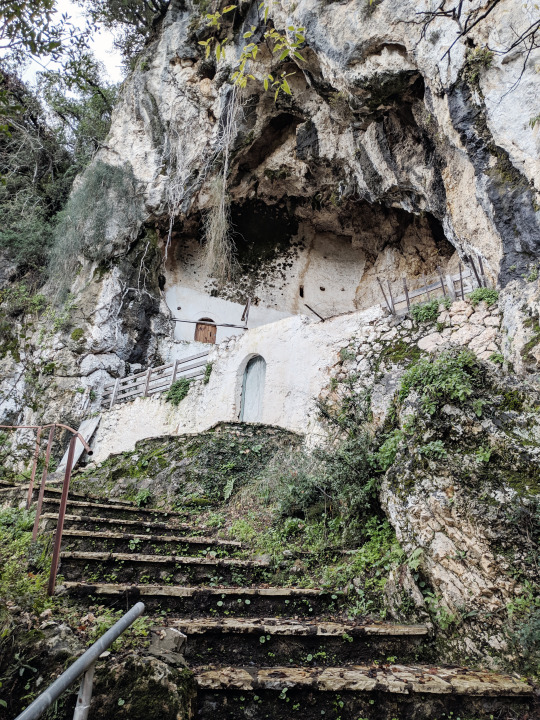
Epirus region in northwestern Greece is an area of many mythical topologies and multi-cultural identities, ranging from the Venetian influence in the coast to Ottoman villages in the interior. | Photo © Christina Serifi, TiriLab
TiriLab, an initiative and an open platform, explores multi-cultural heritage related to local technologies, gastronomy and culture specifics from rural communities in northwestern Greece. It is a joint venture of collectives and individuals, practitioners and researchers with focus on architecture and territory, local ecologies and digital technologies, circular economy and sharing models, initiated by Christina Serifi and Juan Chacón | Zuloark.

TiriLab focus on building techniques, food research and production as well as territorial research and design through workshops, encounters, research and built prototypes. | Photo © Juan Chacón |TiriLab
At the Epirus region in northwestern Greece they have identified a variety of self-organised initiatives mostly by women. All these cooperatives, associations, informal or formal organisations achieved to survive during greek economic depression and kept these villages alive by producing local products, bartering and organising social events. Christina Serifi explains that “we recognize these initiatives as rural commons sharing multiple resources, such as food and gathering a community around them, by re-using abandoned public infrastructure and creating open kitchens. We are inspired by and wish to learn from real life practices and critical human interventions, leading the way in building alternatives locally and globally.”



TiriLab aim to merge formal, non-formal and informal learning models through rural commons to create encounters with artists, local institutions and inhabitants from and for the region. | Photo © Juan Chacón, Bea Abbott
Mapping the margins would be a series of maps and documentations, identifying, for the first time, all the women associations, local agriculture cooperatives as well as abandoned buildings starting from Thesprotia province in Epirus, in order to create an active platform where many cooperatives can find a space to grow.
Alkistis Thomidou and Gian Maria Socci are observing the way “world went into an unprecedented lockdown, exposing the fragility of a lifestyle resulting from decades of neoliberal policies and individualism” and bring an attempt in 35 Meridians of Radical Rituals to imagine how architecture can reinvent itself to support this venture, learning from non professional practices that are already making a change in our cities. “Shortcomings of public services, migration mismanagement and the failure of addressing climate change demonstrate the need to revolutionize the way we manage and envision our communal space.”

Map of the current research 35 Meridians Of Radical Rituals that looks at Europe as a place of diversity and cultural crossings beyond the usual centres of cultural production. | Photo © Forty-five degrees
An itinerant survey along the 45ºN parallel, a path crossing climates, geographies and borders marked by socio-economic and geo-political struggles, where movements of people, knowledge and goods formed the hybrid place we call Europe. This arbitrary line separating the south we come from and the north where we live and work, is a symbolic space that shifts notions of centre and periphery and invites speculation on a different understanding of borders as spaces of threshold and diversity.

In the proposal for the Greek Pavilion at the Venice Biennale forty-five degrees explored the idea of beekeeping as practice of transnationalism and solidarity. | Photo © Forty-five degrees

Bees become ambassadors of a metaphorical cross-border pollination of the Biennale’s Giardini. If we were producing honey at the Giardini, would this be a Greek honey, an Italian one, or something else altogether? | Photo © Forty-five degrees
Forty-five degrees are convinced that “everyday people's responses to the extraordinary crisis of our times show the power of community in inventing new modes of thinking and making. Although we often overlook or miss them, they show great potential to meet the ecological, economic and societal challenges of today. We are collecting exemplary practices and regard them as rituals, because of their power to create ties of kinship, foster inclusion and spatial identity while strengthening the capacity of collective action.” These take the form of community self-organization, informal gatherings and spontaneous actions that mainly survive through maintenance and care. They point towards an unexpected ressurenge of the commons, encouraging new forms of citizenship and new types of care for life forms. They show how radical innovations, new traditions, memories and technologies can generate alternative futures of living together across physical and digital space.

Forty-five degrees is focusing on mapping and recording informal acts of care that are already making a change in our cities. Here the example of containers. | Photo © Forty-five degrees
Lemonot is a design and research platform, founded by Sabrina Morreale and Lorenzo Perri, interested in iconographic gestures enabling the mutual immanence among objects, bodies and rituals. In particular, their work attempts to define peculiar architectural settings for updated gastronomic ceremonies: food preparation and consumption construct a privileged ground to enact symbolic behaviors. Their research focuses on contemporary folklore – as a trigger for unconventional spatial languages, between geometrical abstraction and material figurativism.

A totem of miniatures to re-enact the Mesa de la Challa, AAVS 2018 | Photo © Lemonot
They researched Mamani’s buildings, nicknamed “cholets,” a portmanteau made of the high-class “chalets” (as in, Swiss cottages with eaves) and the derogatory “cholo” (as in, racist slang for an indigenous person). They are build manifestation of folkloric andean rituals. The spacial languages characterizing them are rooted into a procession, traditional mass, mythological characters.
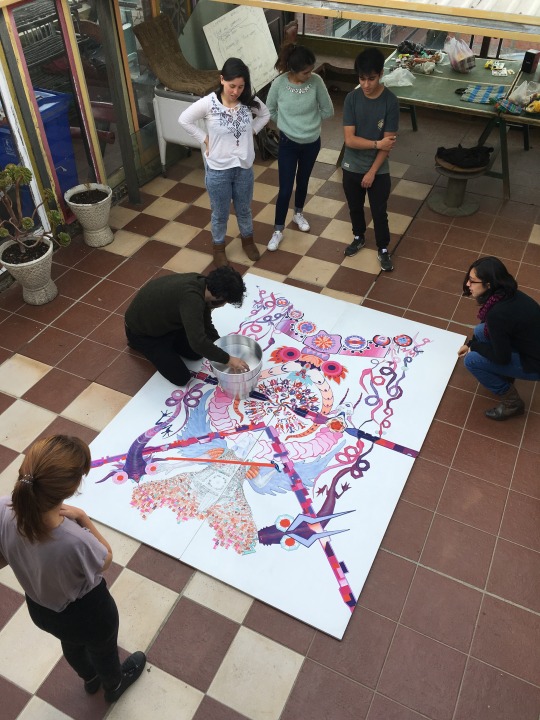
Cultural Assembling, the AA Visiting School El Alto 2018 led by Lemonot.| Photo © Lemonot
Cholets are more than just outlandish buildings with zany colors; they come with the promise of financial returns. In a typical cholet, the ground floor contains stalls that can be rented out to businesses; the second and third floors house a party venue; and on the upper floors are residential apartments. “For me, of course it represents the colors of our culture, but mainly it’s the result of hard work,” says Joaquin Quispe Condori, a restaurateur who co-owns a cholet with a salon called El Crucero del Sur, with his siblings, “I believe that we are really hard workers, and all the effort, it’s [shown] here.” Every owner of the cholet becomes a tycoon, who works and organizes community parties and feasts. Everyone turns to him with condescension and admires him. The colors are in fact inspired by Andean traditions but as well on the owner’s choices.
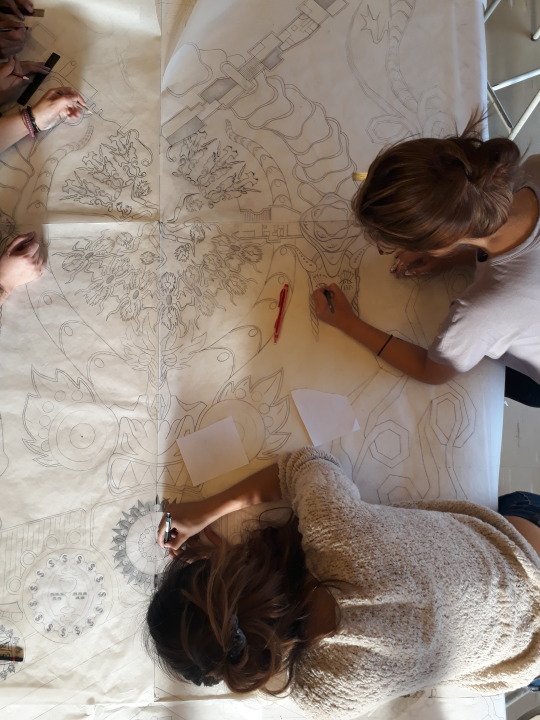
Drawing a collective tapestry to represent the characters of the Diablada, AAVS 2018. | Photo © Lemonot
Controversies 1 (social) Owning a cholet is a powerful status symbol that announces the attainment of wealth. The cholets constitute new markers of wealth inequality in a city whose emerging cholo bourgeoisie increasingly contrasts with, for example, the poor street vendors who set up shop right outside their front doors.
Controversies 2 (commodification of traditional rituals) Three days a week in the city of El Alto, cholitas dressed in their traditional outfits battle it out in the ring in an event that’s a hit with locals and a top tourist attraction. These women are theatrically performing for tourists, betraying the values of their traditions.
Controversies 2 (commodification of traditional rituals) It is not the only exaggerated event or ritual to entice tourists to come. The preste, which is a folloric moment for the aymara, becomes today an electronic party with international djs and sponsors that takes place inside the cholets, once a year. Traditional dancers, masks and cholitas are dancing covered in led lights. A form of celebration or gentrification?
Controversies 3 (political) The rise of Freddy Mamani’s architecture and the government of Evo Morales is strictly linked together. Evo won with 53.7% of the votes, an absolute majority, unusual in Bolivian elections.
Controversies by Daniel Runnels (2019) Cholo aesthetics and mestizaje: architecture in El Alto, Bolivia, Latin American and Caribbean Ethnic Studies, 14:2, 138-150, DOI:
***
What is the purpose of your community?
Forty-five degrees is an architecture and urban design practice dedicated to the critical making of collective space. Our particular interest lies in Europe, this hybrid place in constant mutation, where we are investigating emerging transcultural traditions, memories and technologies and their potential to shape radical practices of commoning grounded on spatial justice and environmental awareness.
TiriLab is a joint venture of collectives and individuals, practitioners and researchers with focus on architecture and territory, local ecologies and digital technologies, circular economy and sharing models. We work closely with women cooperatives, associations and rural initiatives in Thesprotia province in Greece, aiming to create an active knowledge network, in order to empower them, give them visibility and foster their multilayered identity. Our main objective is to visualize the territory as a whole, as a shared cultural space and add a plural voice to the urban-rural dichotomy discourse, raising awareness of their interdependence by reorganizing relations and practices, through a culture of solidarity.
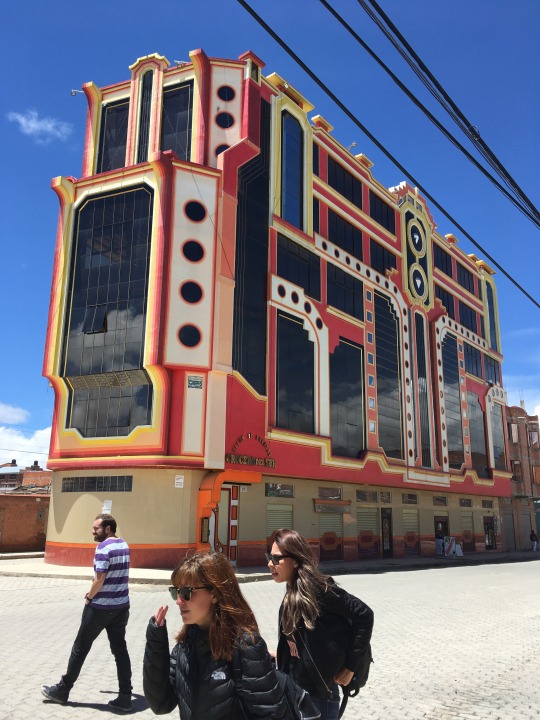
Cholet El Crucero del Sur, site visit with Freddy Mamani Silvestre. | Photo © Lemonot
Lemonot: The AAVs El Alto was held for the first time in January 2018 as an educational programme in La Paz, Bolivia on behalf of the Architectural Association in London. It takes the form of an intensive workshop - everyday full-time for two or three weeks in a row - involving students of architecture, art, fashion, film-making and anthropology. The programme explores through different media the relationship between architecture, cultural identity and rituals in the Bolivian Altiplano, with particular emphasis on the understanding of the cholets constructed by Freddy Mamani Silvestre. International students from all over the world have the chance to work collectively with local ones, experimenting together with heterogeneous sets of references and teaching methodologies.
How do you create a community network (digital, personal, combination)?
Forty-five degrees: Since we started collaborating, we often happened to be physically in different cities, countries, continents, time zones etc. To sustain our community we make use of digital tools but also meet physically when possible. Through research and design, on-site workshops, collaborative and educational formats in multiple scales, we try to understand the locality of each project and seek for moments of entanglement and empowerment of the local community, aiming at creating collective and inclusive spaces.
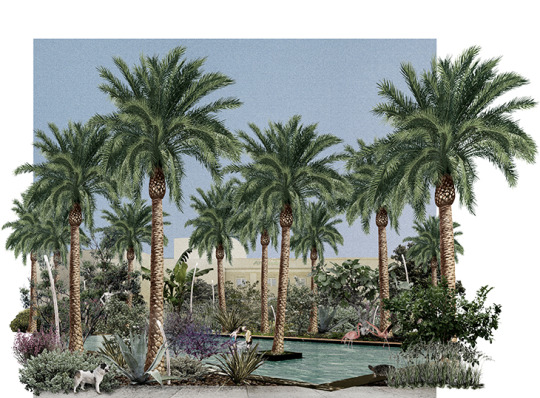
In Rhodes we proposed to turn a concrete plaza into a community garden organized according to the natural ecology of an oasis, recuperating winter rainwater for summer refreshment. | Photo © Forty-five degrees
TiriLab: TiriLab was born with the aim of creating, participating and being part of communities, trying to gap binary concepts of roles and contexts: urban and rural, face-to-face and digital, expert and community. Since we are in a very early stage of community engagement we are working on different levels of approaching. On one hand, we are mapping the territory, through the project “Mapping the margins”, for possible partners, associations, local administrations and civic society groups to create a local network for developing activities. This is an ongoing project and has brought together very interesting groups and initiatives. We have started creating encounters and workshops will local women associations through cooking, prototyping and discussing. All these local informal or formal organizations achieved to survive during greek economic depression and kept their communities alive by producing local products, bartering and organizing social events. We value and identify these initiatives as rural commons sharing multiple resources.

Masks from ordinary moments, AAVS 2019. | Photo © Lemonot
Lemonot: Students are recruited mainly online, through an open call on the AA website. However, especially for the ones coming from La Paz and El Alto, the word of mouth is quite important: we always try to advertise the workshop firsthand in different Bolivian universities, getting to know students in person as much as we can. Indeed, before launching the Visiting School, in 2017 we lived in La Paz and it was not only an amazing experience, but also an essential opportunity to familiarize with the daily realm of such a peculiar context. This coming May we are organizing Tales from the Altiplano: a series of Instagram lives with artists, photographers, architects and anthropologists. We are collecting materials to take stock of our experiences about New Andean Architecture in La Paz and this will set the basis for a series of publications concerning daily practices and rituals, highlighting how they often come with a spontaneously rich iconographic apparatus that should consciously inform the production of spatial languages.
How and which people do you involve?
Forty-five degrees: Our projects and research are based on collaborative work. We are very interested in the acts of spontaneous appropriation as a means of co-authorship and agency. Therefore, in all our projects we include final users by providing open frameworks for them to reinvent their own urban experience. Most of all, we are interested in discovering impactful urban practices that often fly under the radar of professional recognition. Therefore we try to uncover the hidden actors who run and maintain the city as active participants in our decision-making processes. These might comprise retirees, street-sweepers, gardeners, and in general citizens who are not normally included in the conversation, a temporary community of "city heroes".
TiriLab: On a second scale, we also invite every year (Summer of Nothing), mostly international professionals who have developed projects with different communities around the globe in rural or urban areas. Together we enjoy, discover and research the region and its secrets in a profound way in order to bring another perspective in the local context. Our aim is to initiate the creation of a digital platform, relating it to a shared transitional territory which is inhabited in a non-binary way. What if we consider just one environment with digital and physical capabilities?Digital connection and internet are very recent arrivals in several communities in Thesprotia. In TiriLab we are starting to plan how some of the groups operating in the area could be more engaged with the digital world, to gain visibility and also to have the opportunity to exchange knowledge with the groups operating further away from them, if they are willing to.

Crafting ceramic pieces is the studio of Mario Sarabia, AAVS 2018. | Photo © Lemonot
Lemonot: In addition to the students that change every year, we created a network of academics, architects, artists, film-directors, photographers, theatre actors and various artisans. In La Paz and El Alto we found a community of creative people really open to collaborate and this led to fascinating and unexpected interactions: last year we were fabricating props for a spatial performance with a brilliant crafter that usually repairs pieces for airplanes!
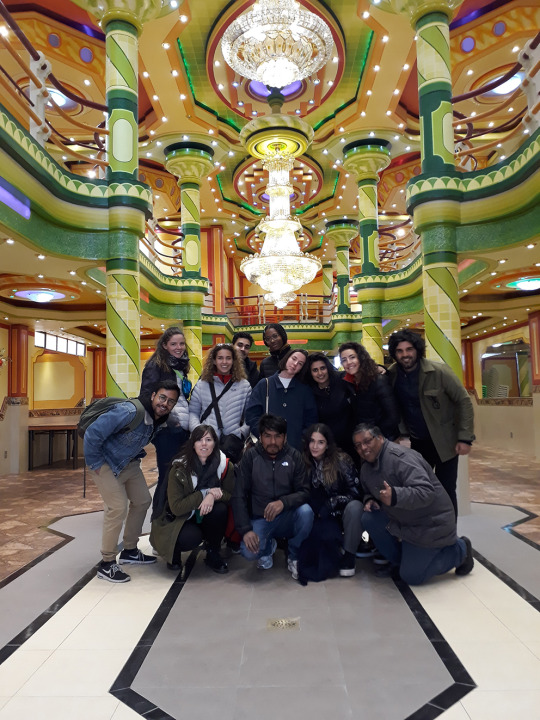
Portable Cholets, the AA Visiting School El Alto 2019 | Photo © Lemonot
2 notes
·
View notes
Text
What Absolutely Everyone Is Saying About Ivory Coast E-visa and What You Should Do
http://pl.ivisa.com/ivory-coast-e-visa
Ivory Coast E-visa Can Be Fun for Everyone The National Assembly doesn't have the political clout required to pass any actual legislation of substance. Catholic and Muslim are the two primary religions here. Normally a family in Ivory Coast is made up of the husband and over two wives with children on account of the predominance of the polygamy.
The state caught more than a million lbs of fish in 2012. The nation's climate and worldwide prices are major things that influence the economy. It's thus imperative to spot and develop indigenous food resources.
Nationals of some countries do not require a visa to go to Ivory Coast. Birdlife is plentiful throughout the nation, but particularly so close to the coast.
Ivory Coast E-visa for Dummies If you are inclined to share but we cannot pair you with a same-gender roommate, you aren't going to be charged the single supplement fee. It's a derogatory term, much like the term anchor baby that is utilized to describe U.S. citizen children of immigrants. Harvard seemed like an ideal location.
Employment opportunities attract huge quantities of workers from neighbouring nations. Media outlets in the USA perpetuate lots of negative stereotypes about immigrants. Schools deliver similar standards of schooling around the world, providing for a simple transition between schools whether they're in France or Vietnam.
For troop contributing countries, missions serve as a means to train and earn experience while having the UN pay for many of the costs. Many of Cote D'Ivoire's mineral resources aren't exploited as a result of political instability and too little direction and investment. Examine the crime rate and number of traffic accidents at any cost, and if you're able to afford it, aim for a secure and quiet community with plenty of green places, very good schools and day-care centers, respectable healthcare centers and so forth.
The event dates vary based on the lunar calendar. It's also important to think about the specifics of your journey. When you have information about an orphanage or photos of Abidjan than we can increase the website than please don't hesitate to get in touch with us to put it to the site.
Ok, I Think I Understand Ivory Coast E-visa, Now Tell Me About Ivory Coast E-visa! Say you want to have an editable India map. For instance, the national development strategy depending on the MDG and PRSP does not expressly integrate migration for a development axis. These materials provide a lot of advantages especially because of their durability and weather resistance.
The Basic Principles of Ivory Coast E-visa That You Will be Able to Learn From Beginning Today The city is situated on the Ebrie Lagoon. Being a significant country you want to prioritize what destinations and attractions you wish to visit. You can find a number of old colonial buildings, though a lot of them are run-down and decrepit but a number of the finger buildings are maintained as tourist attractions.
On most of our tours Explore are going to be able to supply a private transfer at an extra price tag. Don't let yourself be quick to accept the first offer you become. It's important you've got insurance.
The Supreme Strategy to Ivory Coast E-visa Divorce and separation aren't common. Healthy trees seem to die within a couple of days to a couple weeks, which is the way the disease came to be called Rapid `Ohi'a Death. You should choose the guest list, menu, and theme after possible so that you won't feel overwhelmed.
Finding Ivory Coast E-visa Online Kicking back on a patio, with family and friends, can be among the most relaxing and pleasurable activities during the summertime. Comfortable Seating During the Summer, you'll be spending plenty of time outdoors meaning that it's absolutely vital that you purchase patio furniture that's comfortable. Although you might be excited to get a new patio furniture set it is essential that all the right steps are taken to guarantee you wind up getting the best pieces that agree with your space.
If You Read Nothing Else Today, Read This Report on Ivory Coast E-visa Summer is the opportunity to relish your patio or backyard with your family and friends, while it's a low-key social gathering or a huge summertime soiree. Designer clothing can be purchased in boutiques in the city. Grains and vegetables are usually served with a number of sauces and fresh fruit is a typical dessert.
1 note
·
View note
Text
Back in the Day, ‘queer bait’ was basically a derogatory term for bisexual people, or anyone who wasn’t ‘’really queer’’ or ‘’queer enough’’. It meant someone who was a sort of ‘’tourist in denial’’, like they wanted to hang around ‘’real’’ queer people for the ~aesthetic and not commit to activism or solidarity or long-term relationships [you know, your standard bullshit assumptions about bi people- ‘’queer bait’’ was just an efficient means of spouting off biphobia/internalized homophobia.]
Which is why I reflexively side-eye anyone that uses it.
Now, I watched this whole process unfold, in real time: Since ‘’queer bait’’ came to mean ‘’my boring white male ship isn’t canon’’ on tungle dot hell, the rhetoric has morphed into something even more insidious. Now certain people in the community just use ‘’cishet’’ as the term of choice, not to describe actual cis het people, but ‘’people I don’t like’’. Bisexual, ace, aro, self-identified queer people, etc are really just ‘’cishets in denial’’ from ‘’mogai hell’’ who are ‘’infiltrating our spaces’’ and all this aneurysm-inducing bullshit.
It’s insidious because anyone who isn’t clued in to what is really being suggested in some of these posts assumes they’re talking about actual cis het people, and it gets mixed into legitimate critique of cis het people. It’s the perfect way for your shortsighted bigotry to metastasize through the community like a fucking cancer.
It’s used in the exact same way TERFs use ‘’men’’ to actually mean ‘’trans women I hate’’, so well-meaning people will uncritically reblog their shit. It’s a tried and true technique for surreptitiously taking a crack at people you don’t like without being called out for it.
And it’s all, like, teenagers spouting this stuff. And they think it’s cool and edgy or something, to gatekeep and bully people who don’t strictly identify as either gay or lesbian for being ‘’fake cishet tourists’’. But it’s literally just the same old internalized bi/homo/phobia that ‘’queer bait’’ used to represent.
I been watching the same tired bullshit get a fresh coat of paint on an annual basis for the last 15-16 years, almost as long as some of these people have been alive. It’s nothing new at all.
282 notes
·
View notes
Text
Traveling to Denver? Here are some ideas
This place is frequently chanted as the Mile High City because it is one mile above the sea level. This is why Denver is known for being one of the highest cities in the US. However, there is much more to the name than you think. This city is surrounded by stunning Rocky Mountains and is located close to the High Plains in the east. With a mild population of 0.65 million, Denver is an aggregation of food, culture, arts, mind-boggling natural landscape, and everything that you can think of. For people who are obsessed with history, Denver has several incredible museums, housing artifacts over 2000 years old. Now that you have decided to visit Denver, we will guide you through the best things to do there. Continue reading this passage until the end:
1. Take Local Transportation
If you want to enjoy the popular culture of this city, there’s nothing better than engaging with the locals although, the local transport of Denver isn’t often applauded, a trip in the local bus or train will give you a chance to know about the life of the people living there. The reason why we suggest you travel to the local transport is that it sifts you throughout the city. Especially if you want to visit the different towns of Denver city, the local transport will cost less and give you plenty of time to check out every street. Secondly, when you arrive at the Denver International airport, the local transport will escort you to the Downtown. For just $15, the local taxi or train will help you in arriving at your hotel. However, if you want to take a tour of the entire city with no obstacles, it is in your best interest to rent a vehicle. Despise drinking while driving. Otherwise, you will be hounded by the cops. In case you are convicted with a DUI charge, you need to contact the San Diego DUI defense lawyer as soon as possible.
2. Visit Museums
Denver is rich in arts and history, which is why it is known as a historian’s paradise. For instance, if you want to start somewhere, you can choose the Rockies Air and Space Museum. This is an interesting place for families and people who are obsessed with jet planes. This venue encapsulates more than four dozen kinds of planes, including the Thunderflash parasite, Alexander Eagerlock, and a lot more. A tour of this gym will prove to be an educational situation for your kids. Secondly, you must sift through the Molly Brown House museum as well. You will be intrigued to know, Molly Brown was the famous socialite and an activist from the RMS titanic who survived the 1912 sinking of the legendary ship. If you want to know about her life and the way she lived, plan a visit to this museum.
3. Plan a Trip to The Denver Botanic Gardens
If you visit Denver and don’t visit the iconic botanical gardens of this city, you won’t be able to make the most out of your trip. These gardens are a hub of native and artificially grown plants. It is because of the botanical gardens that Denver manages to attract thousands of visitors every year. As you sift through the gardens, you will come across several picnic spots, pools, lily pads, and much more. The botanical gardens of Denver serve as popular venues for several cultural and corporate events throughout the year. Secondly, you will also find classy restaurants in the gardens, so visiting them is crucial for you. If you’re a fan of the Japanese style gardens, you will be thrilled to visit the botanical gardens in Denver.
4. Enjoy The Food
One of the leading reasons why people love to visit Denver is because of its local food. Especially if you like to enjoy the traditional dishes of the US, Denver dishes will suffice for your appetite. When traveling to this city, you will be exposed to Cheeseburgers, veggies, street tacos, green chile, smothered burritos, and rocky mountain oysters. Secondly, if you want to munch on fast food, Denver has several iconic restaurants throughout the city. People who visit Denver can’t get over the cheesy fries complemented with hot sauces. However, if you are on a long trip to this city, it is best for you to eat less. Not to forget, if you eat a lot of food, you will have to frequently stop at restrooms throughout the city. Furthermore, planning a trip to the Rocky Mountains means you will need to keep yourself hydrated with plenty of water and energized through protein bars. So don’t forget to buy the snacks in this city.
5. Sports Authority Field is Amazing
Because Denver is mile high, you can get views of the Rocky Mountains from the sports stadium. Also known as the Mile High stadium. It has been popular for holding several events throughout the year. This stadium is remembered for the famous Super Bowl games of 1997 and 1998. Experts believe their victory was due to the strength of the Mile High stadium. With a seating capacity of 50,200 people, the tickets of this sports stadium often get sold out. So if you’re planning a trip with your family, you must pre-book them in advance. Secondly, the management of the stadium also provides tours to first-time visitors. Furthermore, management also makes special arrangements for disabled people. If you have cemented your decision to visit Denver, don’t forget to visit the mile high stadium, regardless of whether you’re traveling solo or with your loved ones.
6. Enjoy The Fresh air
Are you obsessed with enjoying the fresh air without any pollutants becoming an obstacle in your breathing process? Visit Mount Evans to witness the breathtaking beauty of this place and sift through the rocky terrains. If you don’t know, Mount Evans is the 12th highest peak in Colorado, with a height of 14,271 feet. This peak gives you views of the Pikes Peak and Long Peak near the mountain Bierstadt. It is not easy to reach Mount Evans because of the uneven landscape. You will have to struggle with several bumps in the roads. This means you will have to hire a 4WD car for a smooth journey. In contrast, if you settle for any regular vehicle, it will be hard for you to cover the entire journey easily. However, if you want to make the most out of your journey, we suggest you hike for 3 to 4 hours. This way, you will lose some tummy fat and enjoy the experience of navigating a long trip to the mountains. When you visit this place, you will come across a vast array of flowers and many other intriguing plants.
7. Buy From The Local Industry
Because Denver is a city rich in culture and history, you can make a difference to its economy by shopping from the locals. Keep in mind, you will get thousands of branded products from different parts of the US, but if you’re going to Denver, you must give a chance to the small scale sector over there. One of the leading mistakes a lot of people make is when they flock to the shops of the big names in the business world. Although we are not trying to criticize any, it is best if you can contribute to the economy of this small city. Especially if you want to purchase souvenirs, the local shops will provide you with mind-boggling pieces of artwork. Denver is rich in art and history, which is why the locals are obsessed with manufacturing the replicas of the artifacts in small shapes.
8. The Downtown Aquarium
This is the best venue for the entire family. An aquarium that is home to over 500 species, the Denver Aquarium will be nothing less than eye candy for your kids. When you visit the Denver Aquarium, you will come across the Stingray Reef tank, dive lounge, Nautilus ballroom, and the famous aquarium restaurant. The aquarium has been architecture in an amazing way and presents the sea life in a beautiful way. Secondly, the aquarium restaurant is worth the visit, and the food is economical. So if you want to enjoy a full day trip with your family and have dinner as well, a trip to the Denver Aquarium is going to keep everyone occupied. Denver’s aquarium is one of the most sought after tourist attractions in the city, which Is why it is flocked with visitors throughout the day. Don’t forget to take a few snacks along as you might not get anything apart from the seafood inside.
9. Adams Mystery Playhouse
This place holds the distinction for being the only mystery dinner theatre for the entire family as it is suitable for every age. You will enjoy the stand-up comedy by different actors as they don’t use any derogatory or offensive words. Once you are done with enjoying the dinner, you will witness a sarcastic murder around you. The actors will ask you to help them in looking for cue and refreshments. After this is wrapped up, you can enjoy different drinks and interact with the locals. However, that’s not all, the actors also rewarded the witnesses with souvenir prizes. In case you’ve solved the mystery crime, you will be entitled to intriguing gifts as well. This place is a major attraction for people because of its exterior and the unique color scheme.

Read More
0 notes
Text
Day 47
Thurs 20th Feb
Phil up super early (a bit hungry maybe?) and was keen for breakfast. We had our usual and Phil suggested we walk round to the bay one up from ours. As the official tour guide of ‘Phil & Jess do Africa 2020’, I couldn’t really argue. We found a path on the end of the beach and followed the coastline edge to see where it took us.
It was a cute little path and within 5 minutes we spotted something in the distance that was a bit of a surprise.
Four camels were stood at the top of a hill, grazing on the plants and seemingly free to roam. Alrighty then...
We walked through a little bay and up the hill to get closer and being the ace ventura pet detective that I am I could instantly identifying them as one hump camels 🐪🐪🐪🐪😎.
After enjoying watching these absolute weirdos eating with their sideways mouths and standing on their extremely long legs, we continued trying to find the path to this unknown destination.
I found a route that looked doable and we found ourselves on a derelict concrete site with a big abandoned swimming pool that now resembled a pond. It was right on the edge of this new bay and would have been an amazing spot for a hotel or holiday home. I wondered what had happened to get it to this sorry state.
We found some steps to lead us down to the beach and thats when we noticed more derelict buildings on the land overlooking the beach. They ran all the way along the coast. There were so many empty concrete huts and buildings, it looked like the kind of place you’d make into a paintballing site,. We spoke to some locals who said it was a popular resort in the 60s-80s but there was a ‘money problem‘. It was a crazy amount of wasted space on a beautiful beach with lots of tourists around. Seemed mad to think it had gone from hero to zero in such a popular destination.
Anyway, the water was crystal clear and we could see the tide was out and we could walk to the mini islands and beaches a short distance away. Despite having a bag to carry (good exercise that though Phil) we walked out to sea and is was soooo niiiiiiiiiicce.
The water was cooler than in our bay which made it so much nicer and we reached a little beach next to a big rock island. I did my sea cow impression again and then let Phil have a try (he was surprisingly good at it). We left our stuff on a sand bank and tucked it towards the rock so it was nicely in the shade. And bloody lucky we did too, as the tide came up SUPER fast without us realise it. We casually went back to get our stuff and as we got closer we realised we were about 3 minutes away from it all getting soaked. What a save.
We went to head back and I figured we’d have to walk round the coast again (plus I was missing the camels obvs) but Phil wanted to trying and walk through the town. Hmm I was not convinced this would be the fastest, but Phil was adamant he wanted to try it. The street was dusty and empty and I had a lot of sand stuck to my feet (it may surprise you to know that I really hate sand on my feet unless I’m literally on the beach) and it did not look like a quick way home. But I saw a guy on a bike nip down a little alleyway and thought Hmmm so had a little check on Phil’s phone to see - and by jove it appeared to be that Phil was absolutely right and this would soon get us to the village quick sharp. WHAT A JOYOUS OCCASION THIS WAS TURNING OUT TO BE.
It really was one of the best shortcuts of recent times and I just want to formally take this opportunity to thank and praise Phil for making it happen. Girl loves a shortcut.
As soon as we got back sweaty from the walk, we didn’t stop and walked straight into the pool to cool off. But obviously the water is always boiling in the pool so we quickly got out to hide in the shade.
Hunger appeared rapid though so we went back to the restaurant street to visit our new favourite Swahili place. Big sign saying CLOSED. Oh god DEVESTATED. In a panic, we went to the nice pizza place - Makuti - but they forgot to put cheese on my pizza which was ANNOYING. How could this happen!? So I had to wait for another one. Phil’s marinara with onion and garlic was good though so I ate a load of that.
I went for a walk to buy myself a dress (NOT REALLY that was just a cover story, god I’m so clever, I walked off to see my mate and collect Phil’s shirt).
It was ready on the table when I got there. Very nicely made it was too. But they’d added some hard material to the collar to make it stiff...and it was really quite an orange yellow colour...the pocket material that I’d chosen had also been added round the collar as a detail and it looked a bit like a 90s Paul Smith summer shirt reject...god I’m really not sure he’s going to like this one but we shall see on the 24th 😂
Seeing as these tailor folks were on a roll, I decided to order a few headbands for him too as he’d mentioned he needed one for running. Another present in the bag oh yeah. I found a few scraps of material in the shop and couldn’t decide which one was the least rank, so ordered 3 different ones for $5.
On the way back, I saw some nice trousers (for me) but they must have been children’s sizes as I couldn’t get them over my arse. I did find a square bandana material for $1.50 and it was exactly what Phil was looking for as a neck cover so grabbed that as a little pre-bday gift. I gave it to Phil as soon as I got back and he was really pleased with it. As soon as I saw it on him though, I got a flashback and realised it might be a little bit...gay. I’m not saying that in a derogatory sense, just in a factual sense - I had a vague memory that this type of scarf was a sort of gay symbol. So we sent a video to Nick and Louis quick sharp and awaited the results.
Before dinner, we went to the beach for a drink and I took my iPad to try and do some art. Of course within minutes, some kids came over to look and suddenly we had 10 children surrounding us. I didn't fancy letting them have a go to be honest but Phil reminded me about the face warp photo booth app and so I put it on and faced the camera to the kids. Honest to god, these kids lost their shit. They were HOWLING with laughter. A local bloke came over (tipsy for sure) and they got him to look at the camera and when he saw his warped face, he was so shocked that the kids went wild with laughter. 😂😂😂 It was very very funny.
we walked back to town and crossed our fingers the Swahili place would be open. It wasn’t, so we just went back to Makuti and decided to give a pasta a go. After some entertainment of a stroppy old Italian man refused to move tables and stormed out of the restaurant, we had a pizza (WITH CHEESE) and spaghetti arrabiata with our signature blob of mayonnaise to accompany each dish. We successfully managed to avoid eye contact with any Italians in close proximity while consuming said mayo with their beloved cuisine. Look, its better with mayonnaise I swear. While sat there, a troop of 3 men appeared in the street and did some mental circus tricks and acrobatics. It was incredible, at one point a man was upside down with his head balanced on another mans head and NO HANDS. Evie & Meg would have looooooved it.
Walked home past the little beauty salon at the end of our street and noticed on the sign they offered a service called a MANCURE. Wondered what this treatment entailed and how much they charged for it, as I knew quite a few people who might benefit.
0 notes
Text
Arrival/Day One
When Japanese tourists visit Paris, a significant number of them experience severe panic attacks due to the extreme contrast between Paris as it’s depicted in Japanese culture and Paris as it actually is. All too often they get off the plane, and realize the city they’ve always known as being synonymous with romance and wonderment is actually just as loud, rude and dirty as the next million-person metropolis. Apparently this occurs so often that there’s an actual medical diagnosis, aptly dubbed “Paris Syndrome” (no joke, google it).
As I sat on my first flight leaving Boston on Tuesday night, I couldn’t help wondering if I would experience my own “Tokyo Syndrome” upon touching down at Narita airport. After a childhood spent watching Studio Ghibli films, an adolescence spent playing Nintendo, Sony & Konami video games, and, recently, an affinity for Akira Kurosawa movies and Neon Genesis Evangelion, I was legitimately concerned that my rosy perceptions of the city and Japan at large would be summarily shattered when I arrived. I’m very happy to say they weren’t. Obviously Japan isn’t completely the caricature I had of it before arriving, but that’s a good thing.
I arrived in Japan at around 9AM Tokyo Time (about 8PM EST), and after spending an hour in customs, acquiring my Train Pass, Subway Pass, and pocket wifi station (the most crucial purchase I’ve made thus far, I might note), I took my first bullet train into Tokyo. From there I made my first foray into the labyrinthine complexity of the Japanese subway system (significantly streamlined by Google Maps), and emerged in Kuramae, a relatively quiet (but still extremely densely populated) residential neighborhood where I dropped my bags at my first hostel, dubbed “MyCube by MYSTAYS Asakusa Kuramae” (the first of many examples of strange Japanese English I’ll probably cite on this blog).
It’s worth noting that my hostel is a “capsule hotel,” meaning that my hotel room is essentially a 6'x4'x5’ (that’s L*W*H for you numbers people) cube with a TV, a bed, and a locker beneath it where I store my luggage. For the claustrophobes among you that probably sounds like hell, but so far I’m a huge fan. Once you get your luggage unpacked and feng shui-ed, it’s quite cosy!
Once I dropped off my bags at the hostel, I made my way over to the nearby Akihabara neighborhood. Like Boston, Tokyo is a city of neighborhoods, but at a far greater scale. Akihabara is essentially the gaming and Anime district. I’m a huge fan of the former, but have honestly never really understood the latter outside specific (read: very very good) movies & shows like the aforementioned Studio Ghibli and Evangelion. Aside from that, it’s all weeb (a derogatory term used to denote westerners with a fixation for all things Japan, namely Anime) stuff to me. Akihabara looks like Times Square if you replaced all the surfaces that aren’t covered by screens with more screens. To borrow a phrase from Mike Daisey, it looks “like Blade Runner threw up on itself.” Massive billboards and LED displays clog every surface, and the streets are lined by girls in skimpy maid outfits (Japan’s fixation with girls in uniforms is still something I’m trying to wrap my head around; nearly every girl I’ve seen under the age of 18 has been dressed in a literal “schoolgirl uniform” and it’s really really really weird…) faux-flirt with passerby in attempts to lure them into “Maid Cafes,” where lonely Japanese men pay young attractive girls to pretend to be interested in them. While I try to keep an open mind when experiencing other cultures, this particular aspect of Japan stands out to me as being plain old sad and weird. Needless to say, Akihabara was quite a vibe for my first afternoon in Tokyo.
From there, I proceeded to a nearby Ramen shop and had American ramen ruined for me, forever. Like getting Pizza in Rome or Poutine in Montreal, it’s one of those things where trying the real thing makes all the imitations that much worse. The shop was set up like a bar, with the patrons sitting at a long counter behind which the owner of the shop worked away in the kitchen. Perhaps the best part of the meal was discovering a custom that’s apparently very common in Japanese restaurants; when you enter the restaurant, the entire staff greets you in unison, and when you leave, they thank you in similar fashion. Sitting and slurping my ramen, punctuated by the “Arigato Gozaimas!!”es for each and every patron leaving has been one of the more memorable experiences I’ve had so far.
After that I went back to my hostel, and fell asleep at around 4:30pm. Try as I might to sleep on the plane ride, I’m still wrestling with jet lag as I write this. Thank God for Tylenol PM and Coffee (separately).
This morning, I woke up at around 5. After sitting in bed watching Japanese TV for about an hour, I went downstairs and took advantage of my hostel’s continental breakfast, eating no less than two plates of eggs, ham and croissants, one bowl of cereal and three cups of iced coffee.
After that, I went to go check out Senso-Ji, the biggest shrine in Tokyo. Dozens of teeming streets lined with tiny shops selling all manner of Japan-centric trinkets give way to a huge inner plaza home to several large temples filled with huge paper lanterns, bells, massive paintings and silk screens. I got there at around 8AM, so it was pretty vacant. There’s apparently a huge festival going on there this weekend, and the TV in my hostel cube is currently broadcasting live from there as I write this.
After Senso-Ji, I made my way over to Tokyo Skytree, the tallest structure in Japan. Up until 2010 that honor was held by Tokyo Tower, another massive space-needle style structure on the other side of the city, but in classic architectural-weenie-wagging fashion the Skytree now beats it by about 1,000 feet. It’s so tall that at one point, the elevator to the top was going over 500 MPH. I know because it said so on a display inside. The view from the top was nothing short of spectacular, a 360 degree panorama of the entire city, which goes on as far as the eye can see. For what it’s worth, the Tokyo Metro area is the most populous metro area in the world (which seems like kind of a big deal). At the top of the Skytree, you don’t need the Wikipedia page for Tokyo to know this. You feel it, strongly, from the density spread out below you. It’s humbling to say the least.
From the Skytree, I walked over to the Edo Tokyo Museum, which covers the entire history of the Tokyo region in exhaustive detail from prehistory to the present. Perhaps the most interesting part of this visit was the section of the museum dedicated to the Second World War. Being the only westerner (let alone the only American) in a room filled with somber Japanese people reading about the thousands of people killed in the US firebombings of Tokyo was quite the experience, and I felt a significant degree of guilt-by-association. School taught me we were the “good guys,” (and don’t get me wrong, we were) although it’s exhibits like this one that remind me that war is always shades of grey.
After spending a few hours in the museum, I walked over to Komagata Dozeu, an institution that’s been serving up Dozeu, fish simmering in soy sauce served in a small iron cauldron over hot coals, since 1801. There are no chairs; everyone sits on small pillows on the floor in classic Japanese style. Needless to say it was the perfect follow-up to learning about pre-modern Japan at the Edo Tokyo museum.
That brings us up to the present; it’s about 7pm Japan time and I’ll probably head back out soon to find some food and take in the local nightlife, something I was woefully unable to do last night. The neon-studded nights of Tokyo are the stuff of cyberpunk legend. Hopefully I can be this thorough going forward in recounting my exploits! Thanks to all reading this for sharing in my adventure!
1 note
·
View note
Text
Paris from my window

I am not sure how long this is going to go on for. Especially after a difficult December and January filled with transport strikes (which already restricted many of us to our immediate neighbourhoods), it does feel neverending. It’s like there is no future. Now more than ever before, we can only focus on the standstill present. We can’t know what's going to happen next except that many of us will be unemployed and struggling to make ends meet and we will have to be real creative about how we are going to deal with it.
We are on our third week here in France. Isolating in our homes, confined to our spaces. Paris has had to deal with Covid-19 in an austere manner of course. As one of the hardest hit cities, we find ourselves in complete lockdown unable to wander about, see our friends, or enjoy a cafe ‘en terrasse’. And so, we sit by our windows and watch the world go by. Or rather, we see the world locked in an ‘everlasting present’.
So what does daily life in lockdown look like? As for me, I try to write, create, and tackle the pile of books that’s been staring down at me. But, mainly I nap, nap, and nap some more. Out of boredom? Out of a settling depression? On Monday nights, we listen to the president give us an official announcement on what to expect. Every week it seems like we are told that lockdown will last even longer. Every day we are told about the significant increase in reported cases and deaths; hence, the streets remain deserted and almost apocalyptical.
We are allowed to spend short periods of time (less than an hour) outside for absolutely necessary reasons such as buying groceries, going to the doctor, and walking your dog. Each time however, you have to possess a lengthy written statement on hand explaining what you are doing outside. This statement needs to have your address (so that the police know that you are not gallivanting too far from home) as well as the date and time (so they can control the length of your ‘derogatory deplacement’ as they call it). If the sun is out, you will see a few joggers being surveilled by police. You may even hear a few dogs barking from excitement of finally going out.
Trying to see the light in all this, I can say that Montmartre is still beautiful without its people. A neighborhood usually teeming with tourists now looks and sounds like a secret monastery up on a hill. It’s quiet. It’s disorienting. It’s peaceful. At 8pm we all emerge on our balconies to cheer for doctors, nurses, and every one else on the front-line before retreating back into our homes. Montmartre will always be Montmartre. Even with its slight unearthly atmosphere at this time, a different kind of beauty peeks out. I'm sure the same goes for the rest of Paris but I wouldn’t know for sure.
0 notes